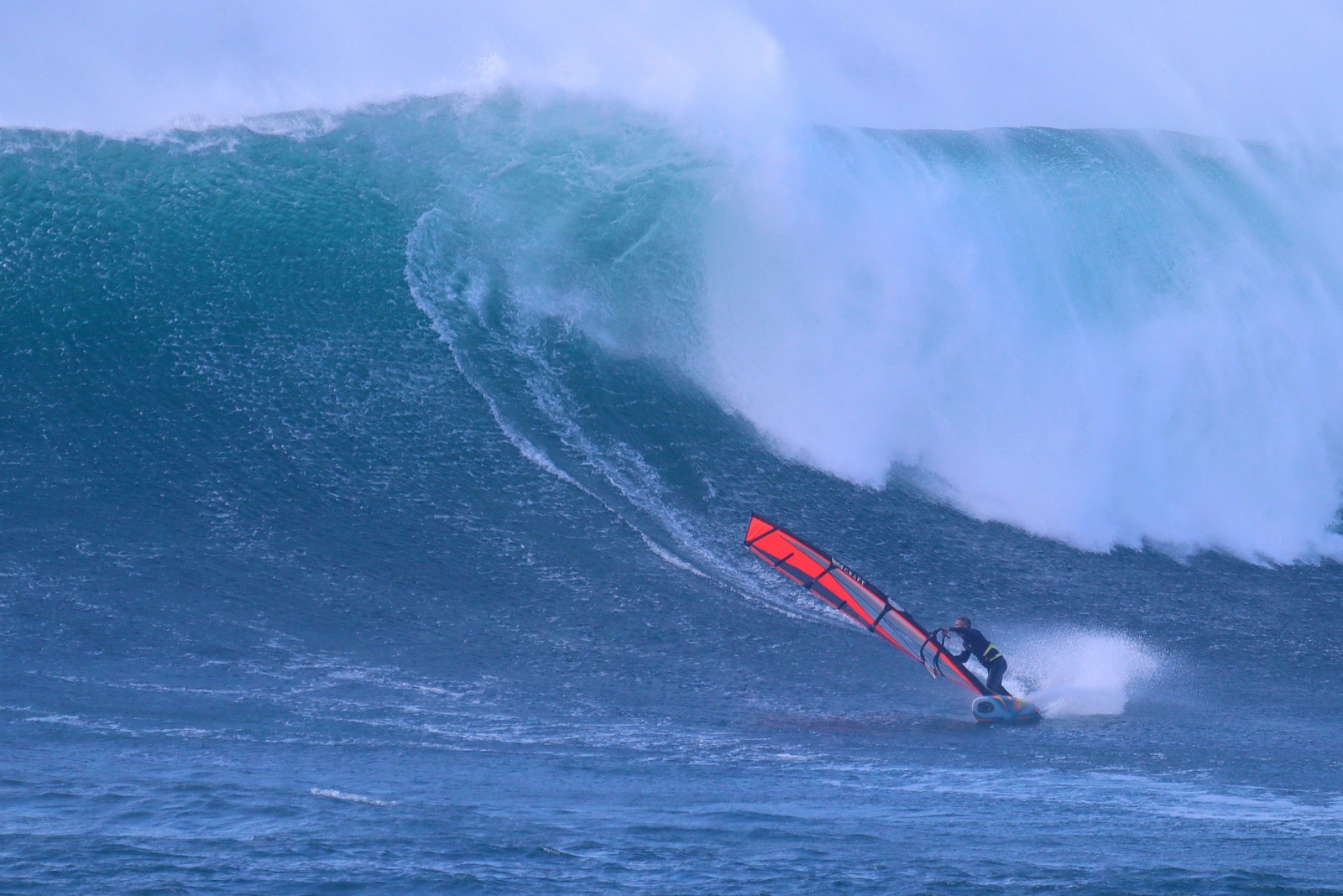Some thoughts on the PWA. Witchcraft does not join the PWA for various reasons. First of all, it is very expensive, especially for small innovative brands. Secondly I think the way it is done actually harms innovation and sustainability. If brands were pushed to increase the range of their gear more by limiting the amount of boards that can be used during a season, would push to develop gear with a bigger range. Also if a rider was punished by losing points for needing more gear due to equipment failure during a season (including free sailing), would push to develop more durable and sustainable gear. Similar to F1 for example. But as end users actually can buy the exact same gear as the pros, it should be even more strict. This would really help those brands producing higher quality equipment. For a start, they could simply publish a statistic for how much gear a rider would have used during a season (or 2 or 3 seasons for that matter). That would help customers deciding which brand to choose. But they don´t publish these things, everything is kept a secret.
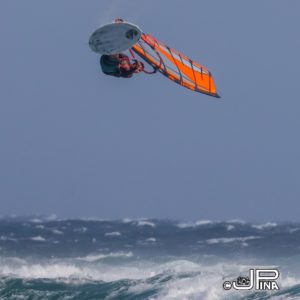
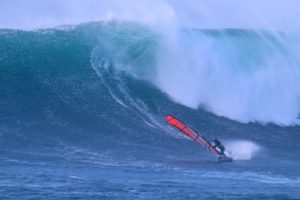
You can choose between a trailer fin type of set up to be really lose to a bigger center fin for more directional stability. Read more about it here: https://witchcraft.nu/boards/trifin/ and here: https://witchcraft.nu/windsurfing-science-witchcrafts…/
First you can see how the pro sailor is more upwind and in a better position but he doesn´t manage to pump onto the wave in spite of his bigger equipment. That is due to having a flat cut sail which in light winds stays flat, just when you need maximum shape. Then he needs to drop into a steeper wave to get on a wave at all which is more risky and more difficult to position on the wave and after the first turn, he has too much drag to out run the lip so the wave closes out on him. Result: Amateur: 1, Pro sailor: 0.
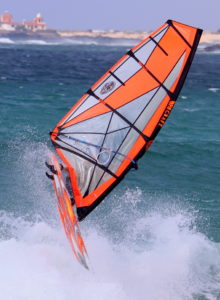 Also on the construction side there seems to be no developments. If anything there are more un-novations with materials like Carbon-Innegra than in-novations. Read more here: https://witchcraft.nu/those-small-but-significant…/
Also on the construction side there seems to be no developments. If anything there are more un-novations with materials like Carbon-Innegra than in-novations. Read more here: https://witchcraft.nu/those-small-but-significant…/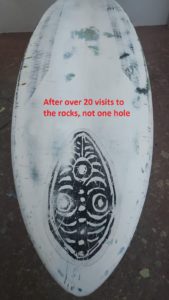
Want to let us know your thoughts?: info@witchcraft.nu
I agree that PWA-rules should limit the amount of board- and sail-types&sizes a competitor is allowed to register for an entire season. This will push to brands to develop gear that suits a larger range of conditions, which is much more relevant for the average customer than squeezing out 5% extra performance from board/sail custom-designed for one specific set of conditions.
I don’t really agree with a rule that would force competitors to use the same one or 2 boards and sails for the entire seasons and penalize them with points if they have to replace broken gear. It would push the brands to develop more reliable gear which is good, but it would introduce a large factor of bad luck to the championship results.
On average, stronger boards & sails will last longer, but in for an individual sailor in a specific season this will not always play out. To what extent you damage your board on the rocks or after a bad landing, or whether you break a mast in a shorebreak, is not solely determined by the strength of the gear. A large part of it is just luck.
The risk on damage is also hugely effected by the spot, so a sailor that trains in a rocky spot ir more likely to danage his gear than one that trains on a sandy beach.
Travel can also cause damage outside the control of the sailor or the manufacturer. Equipment can even get lost.
Some sailors may have 2 or 3 spots where they live and train a lot and will have gear permanently stored on those spots so they don’t have to travel with it.
I guess the biggest difference between the pro-sailor in a competetion and the average recreational surfer is what they expect and need from their gear. There is a world of difference there! Not only the physical fitness and skill-level, but also the complexity of moves, the time spent on the water, the preparation time before a session, …
I remember a test-article in a motor-magazine from a decade ago. They tested a 600cc super-sport roadbike against the fully tuned 600cc racebike based on that same roadbike. The testers were a professional racer and an experienced recreational racer (mid-of-the-pack on national level).
Even on a real racetrack, only the professional racer was faster on the racebike than on the roadbike. The recreational racer was fastest on the roadbike, despite having less horsepower and a bit more weight. The user-friendliness and all-round qualities of the chassis of the roadbike made it the best package for the more ‘regular’ user. If the bikes would have been tested in the real world (the road) the racebike would be far inferior.
I don’t see a way around this; gear will always be optimized for the rules of the competition, whatever they are.
It is the responsibility of the manufacturer but also of the customer to recognize the difference between a competition-environment and a real-world environment.
It is only logical that what is optimal for a competition is almost by definition NOT optimal for real-world use.
That a lot brands market competition-grade equipment to real-world customers is kind of bad but also understandable; many customers choose their gear with their heart instead of their brain, they have a dreamy vision of how they would want their reality to look and brands are eager to sell them that dream.
You see this in all sporting-goods: from tennis to cycling.
Lots of people buy the wrong stuff.
The brands have a responsibiliy to educate their customers but the customers also have a responsibility to use their brain and be realisitic about what they need.
An article like this helps.
But I rarely see an article like this in brand-sponsered media like “windsurfer magazine” or even in the marketing-crap the big brands put out themselves.
This is OK; each brand will end up with the type of customer it deserves.
Answer from Bouke:
It is hard to compare with other sports. Motorbike racing has far less varying conditions plus they use an artificial abundance of power. In windsurfing we use the power of nature so the more efficient you can use this, the better it is both for pro and amateur.
There is no sport where the equipment, that the main brands are offering, has such poor quality for end users, than windsurfing.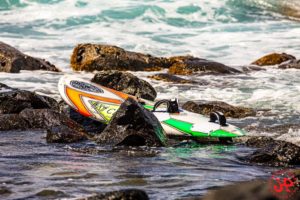
Anyone doing the same stuff as you see in the promotion videos of this equipment, will find the equipment lasting less than a year.
I think we can agree that how they promote the gear, you should be able to do this for at least 2 years?
Technically it is well possible. Even going on the rocks is not a major problem. This board missed some paint but did not need a repair:
In most action/equipment intensive sports, it is well possible to buy high tech gear that will last various years even when pushing the limits.
Most masts indeed are made the best way technically possible and they can still break, that is why they should not have to be included in the limitation of gear. Same for fins but that is because they cost far less. Good booms hardly ever break these days. Even when going on the rocks.
A PWA rider would definately benefit from stronger gear with a bigger range because she/he could travel with less equipment and there is less waste. Just by having loads of equipment ready for any change in conditions, they get around this. So there is less of a push to develop equipment that has a bigger range and lasts longer. Just a push for having more equipment, which is a sign of weakness IMO.
